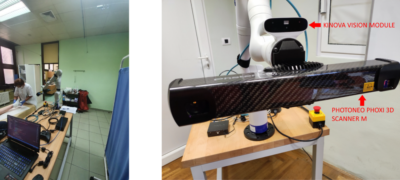
3D reconstruction and analysis of chronic wounds
Partner:
Josip Juraj Strossmayer University of Osijek, Croatia – Faculty of Electrical Engineering, Computer Science and Information Technology (Ferit)
Challenge:
Chronic wounds heal very slowly and the healing process may further be prolonged if ineffective treatment is used. Therefore, clinicians need an objective wound characterization method to evaluate the adequacy of the patient’s current treatment.
The Faculty of Electrical Engineering, Computer Science, and Information Technology (Ferit) at the University of Osijek in Croatia conducts a research project to develop a fully automated system for precise 3D reconstruction, objective measurement, and analysis of chronic wounds.
Solution:
For 3D reconstruction of wounds, Ferit uses the Photoneo PhoXi 3D Scanner model M, which is attached as an end effector to the Kinova Gen3 7-axis robot.
The process looks as follows:
- The PhoXi 3D Scanner scans the wound from multiple viewpoints
- The generated point clouds are integrated into a single detailed colored point cloud
- A 3D mesh is generated
- The wound surface area is automatically segmented and its dimensions (circumference, area, volume) are calculated
- Individual tissue types present in the wound are classified into 3 classes (granulation, fibrin, necrosis)
The whole research project is thoroughly described in this academic paper written by Damir Filko, Domagoj Marijanović, and Emmanuel Karlo Nyarko. The article was edited by Cecilia Garcia and Changsheng Li.
This paper was published by MDPI and belongs to the special issue of the Sensors journal – Robotics in Healthcare: Automation, Sensing, and Application.
Abstract:
“Chronic wounds, or wounds that are not healing properly, are a worldwide health problem that affect the global economy and population. Alongside with aging of the population, increasing obesity and diabetes patients, we can assume that costs of chronic wound healing will be even higher. Wound assessment should be fast and accurate in order to reduce the possible complications, and therefore shorten the wound healing process. Contact methods often used by medical experts have drawbacks that are easily overcome by non-contact methods like image analysis, where wound analysis is fully or partially automated. This paper describes an automatic wound recording system build upon 7 DoF robot arm with attached RGB-D camera and high precision 3D scanner. The developed system presents a novel NBV algorithm that utilizes surface-based approach based on surface point density and discontinuity detection. The system was evaluated on multiple wounds located on medical models as well as on real patents recorded in clinical medical center.”
Discussion:
Automated measurement and analysis of chronic wounds help improve adequate patient treatment, reduce overall costs of healing, and decrease the time of patients’ examination.
This project will also enable open access to a database of annotated wound recordings and 3D models for other researchers and their own researches.
The project “Methods for 3D reconstruction and analysis of chronic wounds” is financed by the Croatian science foundation under grant number UIP-2019-04-4889.
Project leader: Damir Filko, PhD., Associated professor
More information about the project can be found here.
Would you like to know more about Photoneo technology and how it can benefit your applications?

